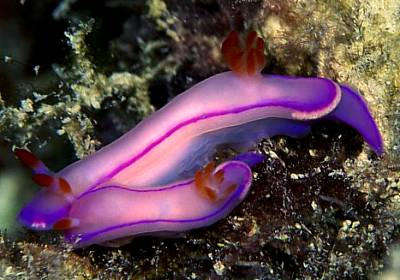
Thorunna kahuna
Johnson & Gosliner, 2001
Order: NUDIBRANCHIA
Suborder: DORIDINA
Superfamily: EUDORIDOIDEA
Family: Chromodorididae
DISTRIBUTION
Known only from Midway and Hawaiian Ids.
PHOTO
Midway Atoll. On pier pilings at 5 meters, 10 April 2000. Photo: Keoki Stender.
The animal is translucent with a pinkish purple tinge, and appears white from the colour of the internal organs. There is a thin submarginal reddish-pink to purple line around the mantle. There is a similar coloured submarginal line around the posterior part of the foot. Around the posterior end of the mantle there is a very distinctive opaque white band of mantle glands, and at the anterior end of the mantle, there are clusters of 3 or 4 similar glands at the edge of the mantle, on each side, in front of the rhinophores. The rhinophore clubs are translucent orange. The gills are translucent white at the base and the upper two-thirds is translucent orange.
In shape and colour Thorunna kahuna is very similar to Thorunna daniellae. According to Johnson & Gosliner (2001) "the most distinct external difference between T. daniellae and T. kahuna is the presence of large, visible mantle glands on the sides of the head anterior to the rhinophores and posterior to the gills in T. kahuna." If glands are present in T. daniellae they are not visible with the naked eye. Thorunna kahuna and T. daniellae also have different radular teeth, with those of T. kahuna having many more denticles than those of T. daniellae. Interestingly, the only two species of Thorunna with visible mantle glands, T. kahuna and T. australis also have very denticulated teeth. Another two differences between T. daniellae and T. kahuna concern the gills. In T. kahuna, the whole of the upper gill is suffused with orange while in T. daniellae, the orange pigment seems restricted to an orange line up the outer edge of the gills. Like most species of Thorunna, this species rhythmically vibrates its gills [see Keoki Stender's message].
References:
• Johnson, R.F. & Gosliner, T.M. (2001) Two new species of Thorunna Bergh 1878 (Mollusca: Nudibranchia: Chromodorididae) from the Indo-Pacific. Bollettino Malacologico, 37(5-8): 143-150.
Rudman, W.B., 2003 (October 1) Thorunna kahuna Johnson & Gosliner, 2001. [In] Sea Slug Forum. Australian Museum, Sydney. Available from http://www.seaslugforum.net/find/thorkahu
Related messages
Re: Thorunna kahuna from Midway
October 5, 2003
From: Keoki Stender
Hi Bill,
Re your question - Thorunna kahuna does wiggle it's gills. No divers can visit Midway so we'll be looking for more specimens at the type locality here on Oahu.
Thanks,
Keoki
fishpicshi@yahoo.com
Stender, K., 2003 (Oct 5) Re: Thorunna kahuna from Midway. [Message in] Sea Slug Forum. Australian Museum, Sydney. Available from http://www.seaslugforum.net/find/11145Thanks Keoki,
It's nice to be able to confirm it's also a 'gill-wiggler'
Best wishes
Bill Rudman
Re: Thorunna daniellae from Midway
October 4, 2003
From: Keoki Stender
Hi Bill,
You are correct about the date, April 10, 2000. Thanks for the information on Thorunna's mantle glands. I'm glad it helps support your research.
Keoki Stender
fishpicshi@yahoo.com
Stender, K., 2003 (Oct 4) Re: Thorunna daniellae from Midway. [Message in] Sea Slug Forum. Australian Museum, Sydney. Available from http://www.seaslugforum.net/find/11088Dear Keoki,
I was right about the date but as you will see from Rebecca's message, I was wrong about the identification. Your animal is in fact Thorunna kahuna. The stuff I said about the mantle glands still hold true for the genus but it does raise the question of why so many species in the genus seem to lack these glands which are a pretty standard part of a chromodorids anatomy. One other thing it would be worth checking on if you get the chance is whether T. kahuna 'wiggles' its gills as it scrawling along. Almost all species of Thorunna exhibit this behaviour. The gills stand upright and rhythmically flick from side to side.
Best wishes
Bill Rudman
Thorunna kahuna and T. daniellae
October 4, 2003
From: Rebecca F. Johnson
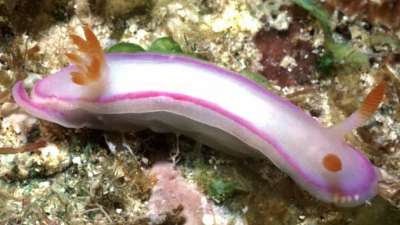
Hi Bill,
Keoki's animal is Thorunna kahuna not T. daniellae. Terry and I named this species in the Proceedings from the Sicily meetings in 2001.
It was previously only known from Magic Island off Oahu in the Hawaiian Islands. I am quoting from our paper here ... "the most distinct external difference between these species (T. daniellae and T. kahuna) is the presence of large, visible mantle glands on the sides of the head anterior to the rhinophores and posterior to the gills in T. kahuna."
I am attaching am image of the the type specimen from Magic Island and a drawing of the mantle glands, so you can see the same mantle gland configuration seen in Keoki's picture. I am also attaching an image of the mantle surface of T. daniellae. This species does not have mantle glands that are visible without an microscope. Thorunna kahuna and T. daniellae also have different radular teeth. I am posting a picture of the radula and jaws of T. kahuna. The teeth have many more denticles than those of T. daniellae. Interestingly, the only two species of Thorunna with visible mantle glands, T. kahuna and T. australis also have very denticulated teeth.
Thanks,
Rebecca
rjohnson@CalAcademy.Org
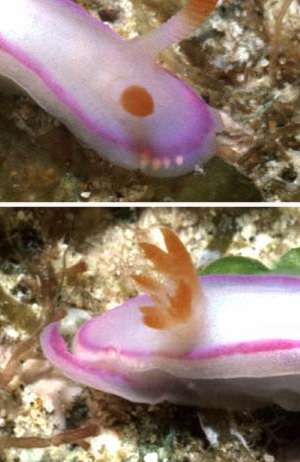
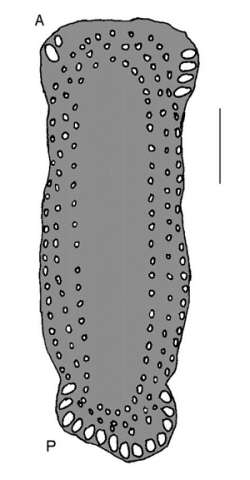
Thanks Rebecca,
My mistake. I thought there was another species with a similar colour pattern but I am afraid my memory let me down. I have attached you radular photos in a separate message and posted a message with illustrations of the radula of T. daniellae. It is interesting how the mantle glands are so obvious in this species but apparently lacking in most others.
Best wishes
Bill Rudman
Radula of Thorunna kahuna
October 4, 2003
From: Rebecca Johnson
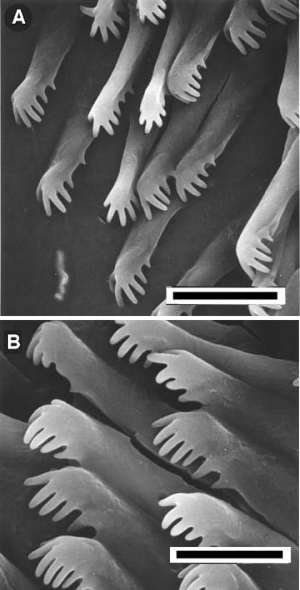
Here are scans of the radula of Thorunna kahuna to accompany my earlier message. They are from:
• Johnson, R.F. & Gosliner, T.M. (2001) Two new species of Thorunna Bergh 1878 (Mollusca: Nudibranchia: Chromodorididae) from the Indo-Pacific. Bollettino Malacologico, 37(5-8): 143-150.
PHOTOS: Scanning electron micrographs of radula of holotype. A, inner lateral teeth on right side. Scale = 15 microns. B, mid-lateral teeth on right. Scale = 10 microns. C, outer lateral teeth on right side. Scale = 10 microns. D, jaw rodlets. Scale = 15 microns.
Rebecca
rjohnson@CalAcademy.Org
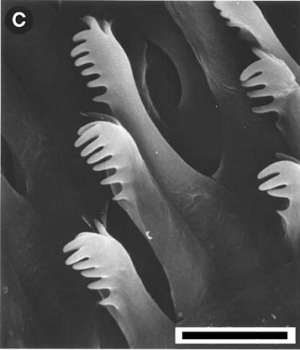
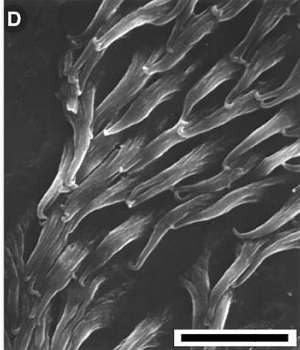
Thorunna daniellae from Midway
October 1, 2003
From: Keoki Stender

Hi Bill,
Here's a photo of what looks like a pink Thorunna daniellae from Midway Atoll. Habitat on pier pilings at 5 meters, taken 10 April 2000. Only seen during that month.
Keoki Stender
fishpicshi@yahoo.com
Stender, K., 2003 (Oct 1) Thorunna daniellae from Midway. [Message in] Sea Slug Forum. Australian Museum, Sydney. Available from http://www.seaslugforum.net/find/11072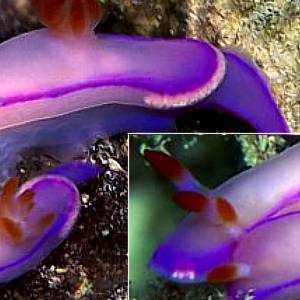
Note added 4 October 2003: This is Thorunna kahuna. See message.
Dear Keoki,
Thanks for this great photo. I have included an enlargement of the posterior and anterior ends of the animals because they clearly show white mantle glands. Such glands are found in most chromodorids, and each genus has a quite distinctive arrangement of the glands. Over the years I have examined specimens of most species of Thorunna and have had very little success in finding any distinctive evidence of these glands in the genus, so your photo is an important bit of information. In a review of the family some years ago (Rudman, 1984) I suggested, that based on many anatomical features, Thorunna belonged to a distinct branch of the chromodorids, which included amongst others, such genera as Hypselodoris, Mexichromis, Ceratosoma, all of which have a concentration of large mantle glands posteriorly. I suggested that if Thorunna really didn't have mantle glands then they had been secondarily lost. Your photo certainly supports my hypothesis that Thorunna belongs to the Hypselodoris 'branch' of the family with prominent posterior glands.
Could you confirm I have the date correct. I try to convert dates so they are understood worldwide. I assume your '4/10/00' is American for 10 April 2000. In my part of the world '4/10/00' means 4 October 2000.
• Rudman, W.B. (1984) The Chromodorididae (Opisthobranchia: Mollusca) of the Indo-West Pacific: a review of the genera. Zoological Journal of the Linnean Society, 81: 115-273.
Best wishes
Bill Rudman
